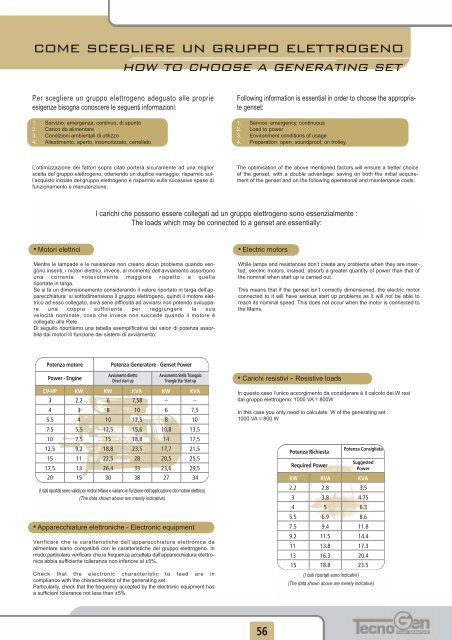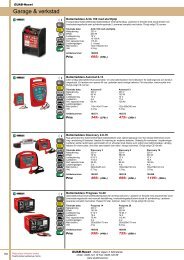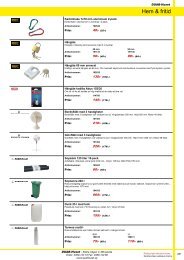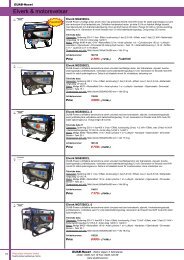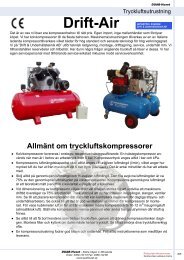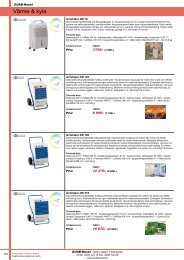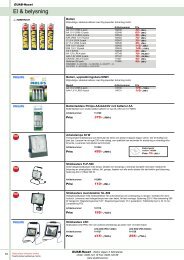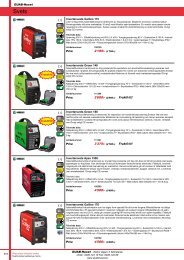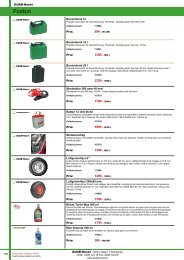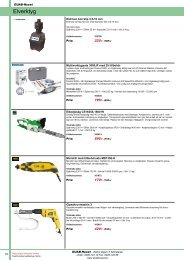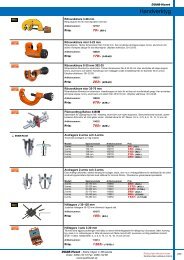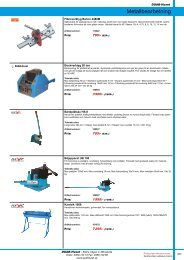comply
catalogo_2006_e def 1.qxp - DUAB-Huset
catalogo_2006_e def 1.qxp - DUAB-Huset
You also want an ePaper? Increase the reach of your titles
YUMPU automatically turns print PDFs into web optimized ePapers that Google loves.
come scegliere un gruppo elettrogeno<br />
how to choose a generating set<br />
Per scegliere un gruppo elettrogeno adeguato alle proprie<br />
esigenze bisogna conoscere le seguenti informazioni:<br />
1. Servizio: emergenza, continuo, di spunto<br />
2. Carico da alimentare<br />
3. Condizioni ambientali di utilizzo<br />
4. Allestimento: aperto, insonorizzato, carrellato<br />
Following information is essential in order to choose the appropriate<br />
genset:<br />
1. Service: emergency, continuous<br />
2. Load to power<br />
3. Environment conditions of usage<br />
4. Preparation: open, soundproof, on trolley.<br />
L’ottimizzazione dei fattori sopra citati porterà sicuramente ad una miglior<br />
scelta del gruppo elettrogeno, ottenendo un duplice vantaggio: risparmio sull’acquisto<br />
iniziale del gruppo elettrogeno e risparmio sulle sucessive spese di<br />
funzionamento e manutenzione.<br />
The optimisation of the above mentioned factors will ensure a better choice<br />
of the genset, with a double advantage: saving on both the initial acquirement<br />
of the genset and on the following operational and maintenance costs.<br />
I carichi che possono essere collegati ad un gruppo elettrogeno sono essenzialmente :<br />
The loads which may be connected to a genset are essentially:<br />
• Motori elettrici<br />
Mentre le lampade e le resistenze non creano alcun problema quando vengono<br />
inseriti, i motori elettrici, invece, al momento dell’avviamento assorbono<br />
una corrente notevolmente maggiore rispetto a quella<br />
riportate in targa.<br />
Se si fa un dimensionamento considerando il valore riportato in targa dell’apparecchiatura<br />
si sottodimensiona il gruppo elettrogeno, quindi il motore elettrico<br />
ad esso collegato, avrà serie difficoltà ad avviarsi non potendo sviluppare<br />
una coppia sufficiente per raggiungere la sua<br />
velocità nominale, cosa che invece non succede quando il motore è<br />
collegato alla Rete.<br />
Di seguito riportiamo una tabella esemplificativa dei valori di potenza assorbita<br />
dai motori in funzione dei sistemi di avviamento:<br />
• Electric motors<br />
While lamps and resistances don’t create any problems when they are inserted,<br />
electric motors, instead, absorb a greater quantity of power than that of<br />
the nominal when start up is carried out.<br />
This means that if the genset isn’t correctly dimensioned, the electric motor<br />
connected to it will have serious start up problems as it will not be able to<br />
reach its nominal speed. This does not occur when the motor is connected to<br />
the Mains.<br />
Potenza motore<br />
Power - Engine<br />
Potenza Generatore - Genset Power<br />
Avviamento diretto<br />
Direct start up<br />
Avviamento Stella Triangolo<br />
Triangle Star Start up<br />
CV-HP KW KW KVA KW KVA<br />
3 2,2 6 7,58 -- --<br />
4 3 8 10 6 7,5<br />
5.5 4 10 12,5 8 10<br />
7.5 5,5 12,5 15,6 10,8 13,5<br />
10 7,5 15 18,8 14 17,5<br />
12.5 9,2 18,8 23,5 17,7 21,5<br />
15 11 22,5 28 20,5 25,5<br />
17.5 13 26,4 33 23,6 29,5<br />
20 15 30 38 27 34<br />
(I dati riportati sono validi per motori trifase e variano in funzione dell’applicazione del motore elettrico)<br />
(The data shown above are merely indicative)<br />
• Apparecchiature elettroniche - Electronic equipment<br />
Verificare che le caratteristiche dell’apparecchiatura elettronica da<br />
alimentare siano compatibili con le caratteristiche del gruppo elettrogeno. In<br />
modo particolare verificare che la frequenza accettata dall’apparecchiatura elettronica<br />
abbia sufficiente tolleranza non inferiore al ±5%.<br />
Check that the electronic characteristic to feed are in<br />
compliance with the characteristics of the generating set.<br />
Particularily, check that the frequency accepted by the electronic equipment has<br />
a sufficient tolerance not less than ±5%.<br />
• Carichi resistivi - Resistive loads<br />
In questo caso l’unico accorgimento da considerare è il calcolo dei W resi<br />
dal gruppo elettrogeno: 1000 VA = 800W<br />
In this case you only need to calculate W of the generating set :<br />
1000 VA = 800 W<br />
Potenza Richiesta<br />
Potenza Consigliata<br />
Suggested<br />
Required Power<br />
Power<br />
KW KVA KVA<br />
2.2<br />
3<br />
4<br />
5.5<br />
7.5<br />
9.2<br />
11<br />
13<br />
15<br />
2.8<br />
3.8<br />
5<br />
6.9<br />
9.4<br />
11.5<br />
13.8<br />
16.3<br />
18.8<br />
3.5<br />
4.75<br />
6.3<br />
8.6<br />
11.8<br />
14.4<br />
17.3<br />
20.4<br />
23.5<br />
(I dati riportati sono indicativi)<br />
(The data shown above are merely indicative)<br />
56


